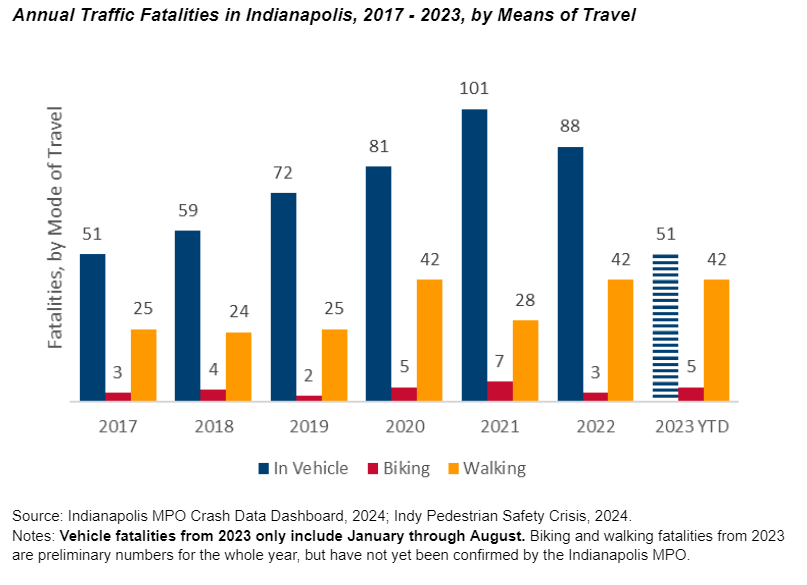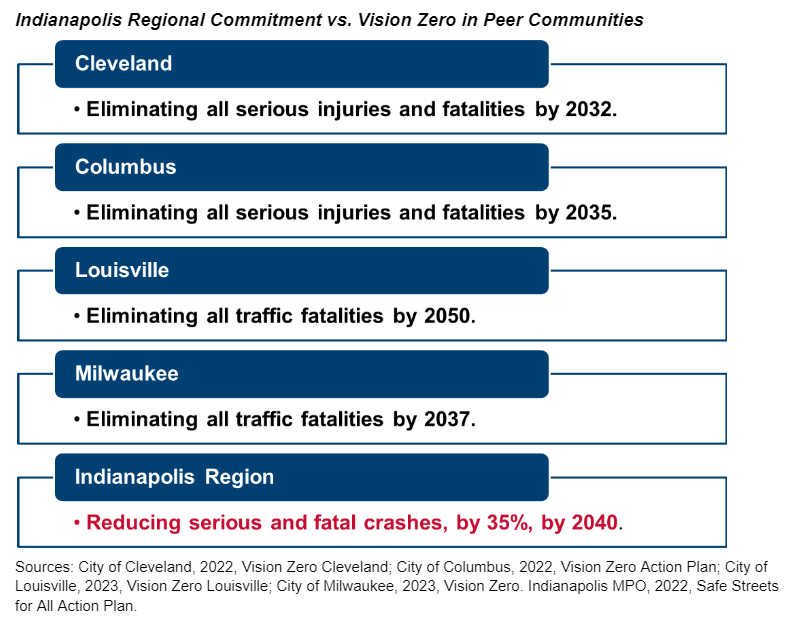Indianapolis Should Commit to Vision Zero
In response to rising traffic fatalities nationwide, many cities are enacting Vision Zero policies which commit to eliminating traffic fatalities and serious injuries. While the City of Indianapolis has taken many positive steps for improving pedestrian and cyclist safety in recent years, it has yet to make a Vision Zero commitment. We are calling on the City to join its peers in recognizing that traffic fatalities are unacceptable and design its roads to deliver on this commitment.
Indianapolis’s Pedestrian Safety Crisis
Indianapolis is in the midst of a pedestrian safety crisis. Since the beginning of 2020, Indianapolis has lost 174 pedestrians and cyclists, and at least 495 people total – due to fatal crashes on its streets. This represents an increase of more than 50% in the annual average fatalities compared to pre-pandemic conditions. The City of Indianapolis has some safe streets policies, but does not yet have a goal to eliminate traffic fatalities. We are calling on them to make this commitment.
What is Vision Zero?
Vision Zero is a commitment that serious crashes are preventable, a statement that anyone dying from traffic violence is unacceptable, and a strategy to reduce the severity of crashes and eliminate traffic fatalities. This is a common commitment of cities around the world, including many of Indianapolis’s peers. According to the Vision Zero Network, the purpose of a Vision Zero policy is to:
Recognize that traffic deaths are preventable;
Recognize that saving lives is not expensive; and
Design roads so that human error does not result in severe injury or fatalities.
While traditional traffic planning practices might dismiss serious crashes as “accidents” resulting from isolated incidents of reckless human behavior, a Vision Zero approach acknowledges that human error is natural. Under this approach, the traffic planning emphasis shifts to lessening the likelihood that crashes result in death or serious injury by designing streets in ways that naturally calm traffic and protect vulnerable road users such as cyclists or pedestrians.
In the last few years, Cleveland, Columbus, Louisville, and Milwaukee have all made policy commitments to eliminate traffic fatalities, and are committing resources and planning efforts to achieve this vision. While the Indianapolis region has produced a similar plan, this plan set its sights only on reducing fatal and serious crashes by 35%. In addition, the City of Indianapolis itself has, as of yet, made no formal Vision Zero policy commitment. We are calling on the City to join its peers in recognizing that traffic fatalities are unacceptable.
The Policy Need
The City and the MPO (Indianapolis Metropolitan Planning Organization) have laid the groundwork to make a Vision Zero commitment actionable. Many of the tools, controls, and policy guidelines have been assembled. For example, in the last few years, the City of Indianapolis has established a new Tactical Urbanism Policy, an updated Complete Streets Policy, and a new Fatal Crash Review Team. Similarly, the MPO has recently established a Safe Streets for All Safety Action Plan and a new Vision Zero Toolkit. We are appreciative of these efforts, and want to thank all those involved in creating and implementing these policies.
However, a policy commitment from the City to eliminate traffic fatalities by a defined date is still needed to unite these disparate policies and support them with financial resources. This would accomplish three things:
Create a clear and specific vision for the future of street safety in the city;
Establish accountability; and
Create a mandate to align road design and assign funding towards the goal of improving safety for all users.
In addition to the City’s current initiatives–the Fatal Crash Review Team, Complete Streets Policy, and Tactical Urbanism Policy–we are suggesting three policy responses that would help achieve this vision:
Commit funding to implement a Vision Zero Policy for the City.
The U.S. DOT is offering SS4A Grants for organizations to implement road safety projects. Applications open in February 2024.
Adopt NACTO Design Standards as the default design for City roads.
The National Association of City Transportation Officials (NACTO) produces engineering guidelines to build streets for an urban context.
These design standards are currently one of many design guidelines that City engineers consult when considering new streets projects.
Streamline permanent implementation of Tactical Urbanism projects.
For example, the Community Heights tactical urbanism project significantly reduced traffic speeds and improved all users’ perceptions of safety. But the project is reverting back to its previous form, and faces a 5-year waiting period for permanent implementation.
The Bike Indianapolis Advocacy Committee plans to submit an official policy request to the City Council to ensure this issue is on their radar.
~ By Chris Holcomb, Bike Indianapolis Advocacy Committee Chair


